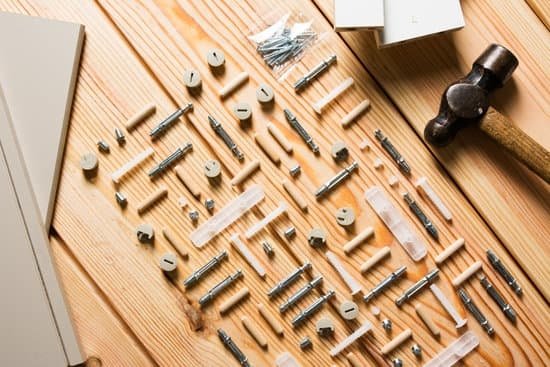Are you looking to add a unique and durable touch to your woodworking projects? If so, understanding how to use spline woodworking can take your craftsmanship to the next level. Whether you are a seasoned woodworker or just starting out, incorporating spline joints into your creations can provide strength and aesthetic appeal. In this article, we will delve into the world of spline woodworking, covering everything from its purpose and techniques to essential tools, materials, and tips for success.
Spline woodworking involves creating strong and decorative joints by inserting small strips of wood into corresponding slots in two pieces of material. This technique is commonly used to reinforce the structural integrity of items like picture frames, cabinets, and tabletops. By using this method, woodworkers can enhance the overall appearance and durability of their projects. In this section, we will explore the basics of spline woodworking and lay the foundation for comprehending its practical applications.
In the subsequent sections that follow this introduction, we will cover various aspects of spline woodworking in greater detail. Understanding its purpose will allow you to see the value it brings in terms of both functionality and aesthetics. We will also outline the essential tools and materials you will need for successful spline woodworking projects.
Additionally, a step-by-step guide on how to create spline joints will be provided so that you can confidently incorporate this technique into your own work. With our comprehensive coverage of this topic, you’ll be equipped with everything you need to master the art of utilizing spline woodworking in your creations.
Understanding the Purpose of Spline Woodworking
Using spline woodworking is an essential technique that adds strength and visual appeal to various woodworking projects. The primary purpose of spline woodworking is to reinforce joints and create seamless connections between two pieces of wood. This section will delve into the specific reasons why spline woodworking is a valuable skill for woodworkers of all levels.
Enhancing Joint Strength
One of the main purposes of using spline woodworking is to increase the strength and stability of joints in woodworking projects. When properly executed, adding splines to joints like miters or butt joints can significantly improve the overall durability and longevity of the piece.
Creating Visual Interest
In addition to reinforcing joints, spline woodworking can also be used to enhance the visual appeal of a project. By incorporating contrasting woods or unique patterns into the splines, woodworkers can add an eye-catching design element to their work. This not only adds aesthetic value but also showcases the craftsmanship and attention to detail in the final piece.
Preventing Wood Movement
Another important purpose of using spline woodworking is to prevent wood movement, such as warping or twisting, especially in larger projects like tabletops or cabinet doors. By integrating splines into these areas, woodworkers can help stabilize the wood and reduce the risk of potential damage over time due to environmental factors or natural aging processes.
Understanding these key purposes of using spline woodworking will provide woodworkers with a solid foundation for incorporating this technique into their future projects. Whether it’s for joint reinforcement, visual interest, or preventing wood movement, mastering this skill can greatly elevate the quality and longevity of woodworking creations.
Tools and Materials Needed for Spline Woodworking
When it comes to spline woodworking, having the right tools and materials is crucial to successfully create strong and visually appealing joints. The primary tool needed for spline woodworking is a table saw with a reliable miter gauge or crosscut sled attachment.
This will ensure that you are able to make precise and accurate cuts in both the workpiece and the spline itself. Additionally, a quality wood glue, such as polyvinyl acetate (PVA) glue, is necessary to secure the splines in place.
In terms of materials, you will need high-quality hardwood or plywood for your primary workpieces. It’s important to choose wood that is straight-grained and free from knots or imperfections, as this will result in a stronger joint. As for the spline material, hardwoods like maple, oak, or walnut are recommended due to their strength and durability. You can also opt for contrasting wood species to add visual interest to your spline joints.
Another essential tool for spline woodworking is a reliable clamp system. Clamps are necessary for holding the workpieces together while the glue dries, ensuring a tight and secure bond between the spline and the joint. In addition, you may also need measuring and marking tools such as a combination square or marking gauge to accurately layout and cut the grooves for the splines.
Ultimately, having access to these tools and materials will enable you to create beautiful and long-lasting spline joints that not only enhance the strength of your woodworking projects but also add an element of craftsmanship. In the next section, we’ll delve into a step-by-step guide on how to create these precise joints using the tools and materials mentioned above.
Step-by-Step Guide on How to Create Spline Joints
When it comes to creating strong and visually appealing joints in woodworking, spline joints are a popular choice. Spline woodworking involves adding a thin strip of wood into a groove to reinforce the joint between two pieces of wood. This technique not only provides structural support but also adds an eye-catching detail to the finished piece. In this section, we will provide a step-by-step guide on how to create spline joints in your woodworking projects.
Preparing the Materials and Tools
Before you start creating spline joints, make sure you have all the necessary materials and tools ready. You will need two pieces of wood that you want to join together, a table saw or router to create the groove for the spline, a miter saw or hand saw for cutting the splines, wood glue, and clamps.
Creating the Groove for the Spline
The first step in creating spline joints is to make a groove in each piece of wood where they will be joined together. Using a table saw or router with a dado blade, carefully cut a groove along the joint edge of each piece. The width and depth of the groove should match the size of your spline.
Inserting and Gluing the Spline
Next, cut your splines to fit into the grooves you created in the previous step. Apply wood glue inside the grooves and on the splines, then gently insert the splines into one of the grooves. Press both pieces of wood together so that they are aligned properly, then use clamps to secure them tightly while allowing time for the glue to dry.
By following these steps, you can successfully create spline joints in your woodworking projects. Remember to take your time and work carefully, as precision is key when using this technique. With practice and attention to detail, you can master the art of using spline woodworking in your projects.
Tips and Tricks for Successful Spline Woodworking
When it comes to successful spline woodworking, there are a few tips and tricks that can make a big difference in the outcome of your project. One key tip is to ensure that the spline material you choose is strong and durable. Since the purpose of spline woodworking is to reinforce joints and add strength to a project, using a sturdy material for the spline is crucial. Materials such as hardwoods or metal are popular choices for creating durable splines.
Another important tip for successful spline woodworking is to pay close attention to precision and accuracy when creating the spline joint. This means taking the time to carefully measure and cut both the groove and the spline itself. Utilizing precise tools, such as a table saw or router, can help achieve clean and accurate cuts for a seamless joint.
Furthermore, it’s essential to consider the orientation of the grain in both the main workpiece and the spline. Aligning the grain direction in a way that enhances strength and stability is vital for a long-lasting joint. Proper grain orientation can prevent splitting or weakening of the wood over time.
Additionally, choosing an appropriate adhesive for securing the spline in place is crucial for successful spline woodworking. Woodworkers often use high-quality wood glue to ensure a strong bond between the main workpieces and the inserted spline. This step should not be overlooked, as it greatly contributes to the overall strength and durability of the joint.
By following these tips and tricks, woodworkers can achieve successful results when utilizing spline woodworking techniques. Whether working on small-scale projects like picture frames or larger furniture pieces, mastering these strategies will enhance the quality and integrity of any woodworking endeavor.
Different Types of Spline Woodworking Techniques
Spline woodworking is a versatile technique that offers a variety of methods to incorporate splines into your woodworking projects. One common type of spline woodworking technique is the use of straight splines, which involves cutting slots into the joint and inserting a straight piece of wood to reinforce the connection. This method is often used to add strength and stability to miter joints, particularly in frames and boxes.
Another popular technique is the use of curved splines, where the slots are cut with a curve or angle to accommodate a matching curved spline. This technique not only adds strength but also provides an aesthetically pleasing detail to the joint. Curved splines are commonly used in tabletops, cabinet doors, and other furniture pieces where visual appeal is as important as structural integrity.
For woodworkers looking to add a unique touch to their projects, segmenting with splines can create eye-catching designs. This technique involves cutting segmented pieces of wood and using different colored woods or grains to create intricate patterns. Segmenting with splines is often seen in decorative bowls, vases, and art pieces where creativity knows no bounds.
| Spline Woodworking Technique | Example Application |
|---|---|
| Straight Splines | Frames, boxes, miter joints |
| Curved Splines | Tabletops, cabinet doors |
| Segmenting with Splines | Decorative bowls, vases, art pieces |
Common Mistakes to Avoid in Spline Woodworking
When venturing into the world of spline woodworking, it’s essential to be aware of the common mistakes that can occur during the process. Knowing what to avoid can save you time, materials, and frustration, ultimately leading to more successful and polished woodworking projects.
Here are some common mistakes to steer clear of:
1. Inadequate Preparation: One of the most common mistakes in spline woodworking is not properly preparing your materials. This includes not ensuring that your wood pieces are flat and straight before creating the spline joint. It’s crucial to take the time to prepare your materials adequately to avoid any issues down the line.
2. Incorrect Spline Size: Using the wrong size of spline for your woodworking project can lead to ill-fitting joints and instability in your final piece. Take the time to measure and cut your splines accurately, ensuring a snug fit within the joint.
3. Rushing Through the Process: Patience is key in spline woodworking. Rushing through the steps can result in inaccuracies, uneven joints, and potential safety hazards. Take your time and pay attention to detail throughout the process for a professional-looking end result.
By being mindful of these common mistakes, you can elevate your spline woodworking skills and create stunning projects with precision and finesse.
Inspiring Spline Woodworking Projects and Ideas
Spline woodworking is a versatile technique that can be used to create a wide variety of projects. From simple picture frames to complex furniture pieces, the possibilities are endless when it comes to using spline joints in woodworking. Whether you’re a beginner or an experienced woodworker, there are numerous inspiring projects and ideas that you can explore using spline woodworking.
Below are some inspiring spline woodworking projects and ideas to get you started:
- Picture Frames: Create unique and stylish picture frames using spline joints. You can experiment with different types of wood and spline designs to add a decorative touch to your frames.
- Jewelry Boxes: Design and build intricate jewelry boxes using spline woodworking techniques. The addition of splines can add strength and visual interest to these small but elegant pieces.
- Cutting Boards: Craft beautiful cutting boards with added strength by incorporating spline joints into the design. This will not only make the cutting board more durable but also enhance its visual appeal.
- Coffee Tables: Construct sturdy and eye-catching coffee tables by incorporating spline joints into the table’s design. Experiment with different wood species and spline patterns to create a unique piece that will be a focal point in any room.
These inspiring projects are just the tip of the iceberg when it comes to what you can create using spline woodworking techniques. Whether you’re working on small or large-scale projects, incorporating splines into your designs can add both strength and visual interest to your finished pieces, making them truly stand out.
Start exploring the world of spline woodworking by considering these projects as a starting point for your creativity.
Conclusion
Mastering the art of spline woodworking can open up a world of possibilities for creating strong, visually appealing joints in your woodworking projects. From adding strength and durability to repairing cracked or broken wood, spline woodworking is a versatile technique that every woodworker should have in their skill set.
By understanding the purpose of spline woodworking and learning about the different types of techniques, you can take your woodworking to the next level. Whether you are a beginner or an experienced woodworker, mastering spline woodworking can help you create stunning pieces that stand the test of time.
In this article, we covered everything from the tools and materials needed for spline woodworking to a step-by-step guide on creating spline joints. We also provided tips and tricks for successful spline woodworking as well as common mistakes to avoid.
With this knowledge in hand, you can confidently explore the world of spline woodworking and take your projects to new heights. So go ahead, pick up your tools and start experimenting with how to use spline woodworking in your next project.
Frequently Asked Questions
How Does a Spline Joint Work?
A spline joint works by inserting a thin strip of wood (the spline) into matching grooves in two adjoining pieces of wood. This method helps to reinforce the joint and prevent it from separating, particularly in furniture and woodworking projects. The spline essentially acts as a mechanical bonding agent, adding strength and stability to the joint.
What Are the Disadvantages of Spline Joint?
The disadvantages of a spline joint include the fact that it can be time-consuming to create, especially if done by hand without the aid of specialized tools like a spline jig. Additionally, if not executed properly, there is a risk of misalignment between the grooves and spline, which could weaken the joint instead of reinforcing it.
How Do You Use a Spline Jig?
Using a spline jig involves setting up the appropriate measurements and angles for cutting grooves into the wood pieces. Once these are established, the wood is then positioned and securely fastened onto the jig.
Then, using a table saw or router with a straight bit, the grooves are carefully cut into each piece according to the predetermined specifications. Finally, the spline is inserted into these grooves using glue before assembling the two pieces together to form a strong and durable joint.

Hi everyone! I’m a woodworker and blogger, and this is my woodworking blog. In my blog, I share tips and tricks for woodworkers of all skill levels, as well as project ideas that you can try yourself.





